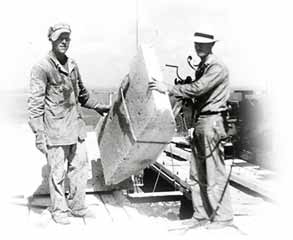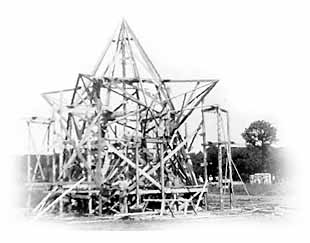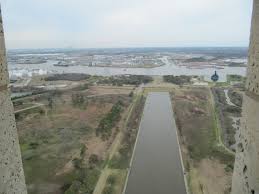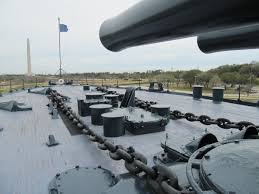For “Travel Tuesday”:
“Texas has yet to learn submission to any oppression, come from what source it may.” - General Sam Houston.

“One of the most revered sites in Texas history is the San Jacinto Battleground - the very place where Texas gained its independence. Today, the San Jacinto Monument and Museum sit atop the plot of ground where Gen. Sam Houston defeated the army of Gen. Santa Anna.
The famous Battle of San Jacinto that brought Texas its independence was fought on this site. Texian troops under General Sam Houston achieved the independence of Texas by defeating a Mexican Army led by General Antonio Lopez de Santa Anna on April 21, 1836.”

San Jacinto Battleground State Historic Site
San Jacinto Monument and Museum
“Most everyone is familiar with the story of the Alamo. And, certainly, everyone realizes Texas eventually revenged that loss and won its independence. However, few people can name the site of the decisive battle in the Texas Revolution.
 Located just a short distance outside of Houston, the San Jacinto Battlefield is one of Texas’ most significant, yet least recognizable historic sites. The Battle of San Jacinto, which took place on April 21, 1836, won Texas its independence from Mexico. The Texan Army, commanded by Gen. Sam Houston, captured General Santa Anna – Mexico’s dictator and leader of the Mexican troops. However, rather than execute the captured leader, the Texans allowed him to return to Mexico after he promised to lobby the Mexican government to recognize Texas as a sovereign nation.
Located just a short distance outside of Houston, the San Jacinto Battlefield is one of Texas’ most significant, yet least recognizable historic sites. The Battle of San Jacinto, which took place on April 21, 1836, won Texas its independence from Mexico. The Texan Army, commanded by Gen. Sam Houston, captured General Santa Anna – Mexico’s dictator and leader of the Mexican troops. However, rather than execute the captured leader, the Texans allowed him to return to Mexico after he promised to lobby the Mexican government to recognize Texas as a sovereign nation.
Although Texas joined the United States 10 years later, the battle’s significance was not diminished. In fact, the Battle of San Jacinto actually paved the way for Texas statehood. Had the Texans not gained their independence, the United States may not have been willing to risk war with Mexico to gain the territory.
.jpg) The San Jacinto Monument, which stands 15 feet taller than the Washington Monument, was completed in 1939. The San Jacinto Museum of History is housed in the base of the monument. The San Jacinto Monument and Museum is open seven days a week, from 9 a.m. to 6 p.m.
The San Jacinto Monument, which stands 15 feet taller than the Washington Monument, was completed in 1939. The San Jacinto Museum of History is housed in the base of the monument. The San Jacinto Monument and Museum is open seven days a week, from 9 a.m. to 6 p.m.
"In future time, then may the pilgrim's eye see here an obelisk point toward the sky...." — Anonymous poet
The above prediction was penned in the poem: “Ode to San Jacinto”, even before the Republic of Texas became the State of Texas. Today, the world’s tallest war memorial stands at San Jacinto—15 feet taller than the Washington monument—honoring all those who fought for Texas's independence.
Immediately after the Battle of San Jacinto, the land—then privately owned—commanded respect from all who walked on its soil. The Texas Veterans Association began planning a formal monument, and the state finally received funding to purchase land in the 1890s. ![]()
![]()

![]()
![]()
Building the monument was hard work. In the 57 hours that the foundation was poured, the builders consumed 3,800 sandwiches and 5,700 cups of coffee.

![]()
![]()
A full-scale model of the 34 foot, 220 ton star was built to test its assembly before the star was constructed at the top of the monument.

 Monument Observation Floor
Monument Observation Floor
Take the elevator up to the Monument's Observation floor, 489 feet above the Battleground, with outstanding views of the city and the busy Houston Ship Channel and harbor. Regular admission.

______________
Battleship Texas State Historic Site


 There are many recreational and educational experiences for visitors and organized youth groups, as well as numerous programs for students of all ages, self-guided tours of the Battleship and Battleground, confined space rescue training, and internships. Learn more about Battleship TEXAS programs and tours.
There are many recreational and educational experiences for visitors and organized youth groups, as well as numerous programs for students of all ages, self-guided tours of the Battleship and Battleground, confined space rescue training, and internships. Learn more about Battleship TEXAS programs and tours.
The 1,200-acre San Jacinto Battleground State Historic Site, which is also a national Historic Landmark, consists of the Battleground, Monument and Battleship TEXAS. It is located within minutes of downtown Houston and a short distance to the beaches of Galveston Island. Millions of visitors come to this area each year to enjoy the mild coastal climate and cultural and sports activities. Visitors can experience history first-hand through living history at the San Jacinto Battleground and Battleship TEXAS State Historic Sites.
San Jacinto Battleground
Walk the Battleground and relive the famous battle for Texas Independence. Granite markers throughout the site designate locations of the Texian camps, the Mexican camps, the site of the advance by Texian forces and other strategic parts of the battle. Most markers can also be viewed from your vehicle. Read or print out "A Battleground Walking Tour Guide." Boy Scouts can earn a badge for this activity. Free admission.
San Jacinto Museum of History
 The San Jacinto Museum of History, operated by the nonprofit San Jacinto Museum of History Association, is housed in the base of the San Jacinto Monument. The museum contains priceless artifacts and dioramas, as well as a rare collection of 250,000 documents and 40,000 books chronicling more than 400 years of early Texas history. Free admission.
The San Jacinto Museum of History, operated by the nonprofit San Jacinto Museum of History Association, is housed in the base of the San Jacinto Monument. The museum contains priceless artifacts and dioramas, as well as a rare collection of 250,000 documents and 40,000 books chronicling more than 400 years of early Texas history. Free admission.
Marsh Restoration and Boardwalk

From the 1,210-foot long marsh trail and boardwalk you can view the native prairie, tidal marsh and bottomland forest as it appeared at the time of the historic 1836 Battle of San Jacinto. Read or print out the Marsh Interpretive Trail Guide: "Habitats of the Upper Texas Coast."
Recreation Area
 Picnic tables, grills and water faucets are available throughout the San Jacinto Battleground State Historic Site. An enclosed picnic pavilion overlooking Buffalo Bayou is available by advance reservation.
Picnic tables, grills and water faucets are available throughout the San Jacinto Battleground State Historic Site. An enclosed picnic pavilion overlooking Buffalo Bayou is available by advance reservation.
______________
On This Day:
Idaho becomes 43rd state, Jul 3, 1890:
“Idaho, the last of the 50 states to be explored by whites, is admitted to the union.
Exploration of the North American continent mostly proceeded inward from the Atlantic and Pacific coasts and northward from Spanish Mexico. Therefore, the rugged territory that would become Idaho long remained untouched by Spanish, French, British, and American trappers and explorers. Even as late as 1805, Idaho Indians like the Shoshone had never encountered a white man.
That changed with the arrival of the American explorers Meriwether Lewis and William Clark in the summer of 1805. Searching for a route over the Rocky Mountains to the Columbia River, Lewis and Clark traveled through Idaho with the aid of the Shoshone Indians and their horses. British fur traders and trappers followed a few years later, as did missionaries and a few hardy settlers. As with many remote western states, large-scale settlement began only after gold was discovered. Thousands of miners rushed into Idaho when word of a major gold strike came in September 1860. Merchants and farmers followed, eager to make their fortunes "mining the miners."
By 1880, Idaho boasted a population of 32,610. In the southern section of the territory, many settlers were Mormons who had been dispatched from Salt Lake City to found new colonies. Increasingly, Idaho territory became divided between a Mormon-dominated south and an anti-Mormon north. In the mid-1880s, anti-Mormon Republicans used widespread public antipathy toward the Mormon practice of polygamy to pass legislation denying the predominantly Democratic Mormons the vote.
With the Democratic Mormon vote disarmed, Idaho became a Republican-dominated territory. National Republicans eager to increase their influence in the U.S. Congress began to push for Idaho statehood in 1888. The following year, the Idaho territorial legislature approved a strongly anti-Mormon constitution. The U.S. Congress approved the document on this day in 1890, and Idaho became the 43rd state in the Union.”
____________
Yesterday:
Misty and I went to get Jay, while Ray finished up some painting in the cargo trailer. Jay did some more repair to the bridge and a soffit vent.
A while back, we had to replace one of the soffit vents on the front of my house. We discovered that the contractors who built the front part of the house, hadn’t even cut out the plywood under the vent. An inspection of the rest of the front vents came up with the same stupidity. No wonder my attic was so hot.
Thirteen years ago, my late Johnnie and I built the back half of the house, and we know those vents were cut out. We lived in the first part of the house for three years, which was really just supposed to be a more spacious area to use with the motor home right up next to it. Back then, it just had a full bathroom with washer and dryer, bedsitting room with Hide-A-Bed, full kitchen, and grooming room, which had a second toilet in a closet. We plumbed and wired it too, and put 30 amp RV outlets, on dedicated circuits, on each side of the house. It was just going to be our winter base, and it was like the casitas that some have on their RV lots.
Then Johnnie got sick so we knew we had to get the house expanded for full time living. So contractors came in and enclosed the attached RVport to make it a garage, added a big living room, hall, middle room and second small bathroom. We moved into the 8x42 trailer that I had next door while all this was going on.
Just about everything they did was way below our building standards, but we didn’t know as I was busy taking Johnnie for daily radiation and other health related appointments. The contractors moved the washer and dryer into the garage, and I had to get them to come back and put traps in the washer and utility sink drains, as the sewer smell was coming into the garage. Just silly stuff like that. The boss of the company wasn’t overseeing the job, as he was trying to finish up another job elsewhere, and the workers that were here preferred to do short cuts, and didn’t really have the right knowledge, apart from being high some of the time. Later, the boss did what he could to make things right and had to come back with an electrician as all the outlets had the wrong polarity. Johnnie died the day after we moved back in, so I have had to contend with this by myself since then.
So now, after 10 years, I am still finding out things that the workers did wrong. So Jay and I will be working on soffit vents again, today.
















5 comments:
I just can't stand people who do not do as good a job as possible. My ole Daddy use to tell me that no matter what the job was from sweeping floors to CEO, always do the best that you can. I always did, up until now, I am slowing down and taking more shortcuts.
I wonder if the workmen had any idea of the grief they were causing, or if they were too ignorant to know better.
I really like parts of southern Idaho but didn't care too much for the Panhandle. I think that was because of the traffic around Spokane & Coeur d'Alene though.
Thank you for your comments, Dick and Gyspy.
The job was going to be paid when they submitted pictures of the finished house to the original contractor, who never was here. As long as it didn't look shoddy in the pictures, the workers couldn't care less. Their boss did come back and paint some of the outside trim, after he saw it when he came back with the electrician. But Jay and I had to rehang some of the doors, as the front part of the house shifts according to the weather.
Happy Tails and Trails to you both, Penny
Not trying to tell you what to do, but I read your post to Steveio. He suggested before you cut away on those soffit vents, leave them alone and cut a ridge vent instead. It will be a lot better for ventilation in your attic space... his suggestion.
*~*~*~*~*~*~*~*~*~*~*~*~*~*~*~*~*~*~*~
Karen and Steve
(Our Blog) RVing: Small House... BIG Backyard
http://kareninthewoods-kareninthewoods.blogspot.com
Thank you for your comment, Karen.
I have two regular vents, 2 turbos and a thermostatic attic exhaust fan on the back part of my roof, as the way this house was built it can't have a ridge vent. The attic was made so that it could have a second storey in the front, at a later date. I think the hurricane clips would get in the way of cutting one anyway.
Happy Tails and Trails, Penny
Post a Comment